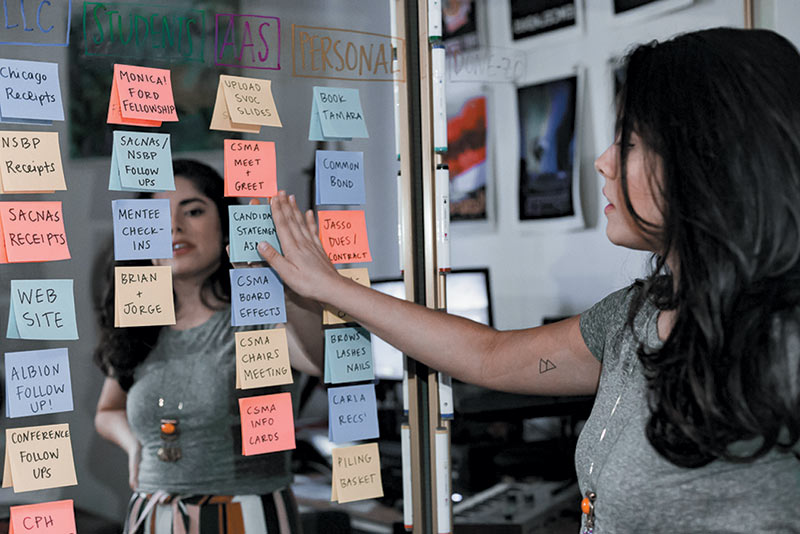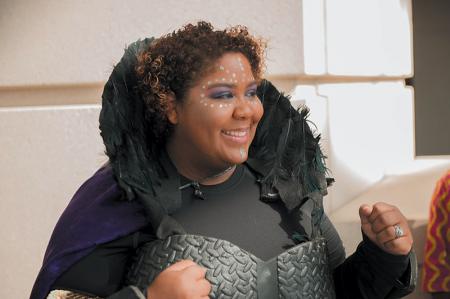Fostering Inclusive Physics Spaces
Fall
2019
Feature
Fostering Inclusive Physics Spaces
Jeremiah O’Mahony, 2019 SPS Summer Intern and SPS Member, Sarah Lawrence College
Physics has a long way to go toward equality. Despite being, arguably, the most universal science, it’s one of the most exclusive. According to data published by the American Institute of Physics, only a fifth of physics PhDs went to women in 2017—and the numbers for physicists of color are lower.1 The percentage of physics degrees at all levels earned by women, African Americans, Hispanic Americans, American Indian/Alaska Natives, and Native Hawaiians are far less than what you would expect based on the US population distribution.2
Changing the national landscape sounds daunting, but think about it this way. Creating a more inclusive local physics community can start with you. If you and your chapter want to take steps toward including everyone, start by listening to everyone. “Empathy is about opening ourselves up to each other’s stories,” said Nicole Cabrera Salazar, a PhD astrophysicist who has launched several initiatives aimed at bringing more young people with minority identities into physics.

To actually hear other stories, though, people have to trust you enough to share themselves. “For someone to be vulnerable with me, I have to be vulnerable first,” Cabrera Salazar said. She recommends “leading with vulnerability”: be the first to open up and share your story.
 Cabrera Salazar admits that learning how to be vulnerable and empathetic is hard. It’s scary to trust someone that you know only through physics. Plus, hearing and accepting someone else’s story grates against one of physicists’ most sacred commandments: No anecdotes. “As physicists, we have the thought process of, Where’s the data?” said Jessica Esquivel, a lesbian, black, and Latina postdoc at Fermilab. “I get that. And there is data. Still, we should give the experiences of those marginalized people a greater weight.”
Cabrera Salazar admits that learning how to be vulnerable and empathetic is hard. It’s scary to trust someone that you know only through physics. Plus, hearing and accepting someone else’s story grates against one of physicists’ most sacred commandments: No anecdotes. “As physicists, we have the thought process of, Where’s the data?” said Jessica Esquivel, a lesbian, black, and Latina postdoc at Fermilab. “I get that. And there is data. Still, we should give the experiences of those marginalized people a greater weight.”
“There is an expectation that human beings can’t be human while they are doing their science,” said Tanmoy Laskar, a queer postdoc in astrophysics at the University of Bath. “Spaces can be made more inclusive by adding pride flags, but [real change happens] by talking about challenges faced by people with other stories.”
“Of course,” he clarified, “that’s not to knock the power of pride flags.” He has a few prominently displayed in his office and recommends that classrooms and lounges should have signs designating them as safe spaces. But before you deck out your classroom or lounge with signs, have conversations with people in the space to make sure that you’re all on the same page about the importance of inclusivity and what that means. “The critical first step is a cultural transformation [aimed] at ensuring all participants behave in an inclusive manner to each other,” Laskar warned. “Without such a transformation, all outward or manifest signs of inclusivity in the space are ineffective and may even be harmful.”
When you’re outfitting your space, make sure you get everyone’s opinion for what goes on the walls and what images are used as screensavers and monitor backgrounds. When new students arrive, make sure they have equal input in redecorating the space. It makes a difference to a new LGBT+ student if he sees a queer scientist smiling down from a poster that he suggested. “The availability of surfaces for affixing decorating allows people to amend the space to express identity,” Laskar said.
On the flip side of that, do your research when you consider posters of famous scientists. While science history is studded with great discoveries, the people who made those discoveries often held opinions that don’t reflect inclusivity—ranging from the slightly problematic to the virulently racist. Be open to taking down certain posters if someone in your space expresses their discomfort. Similarly, be mindful of the range of diversity portrayed on your walls. Physics Nobel laureates are worth celebrating, but a gallery of their faces probably won’t help you create a welcoming atmosphere.
“No discussion of inclusivity is complete without a mention of accessibility,” said Laskar. Along with adding wheelchair ramps, door signs for the visually impaired, and gender-neutral restrooms, he recommends making your space as easy to reconfigure as you can. Making sure that desks and chairs can be moved so the student in a wheelchair doesn’t have to sit in an aisle goes a long way to making them feel included, as does having an option to change lighting for people negatively affected by bright lights or fluorescents. “Reconfigurable spaces are versatile and allow groups of different sizes and intent to set up the space in a fashion most accessible to their members,” Laskar said.
The way we treat each other and carry forward the promises of signs, flags, and reconfigurable spaces is equally important. Even in a classroom with all those things, a stray ignorant slur used in a joke can bring it all crashing down. Don’t use words that have historically been used to bring down marginalized groups—whether or not a marginalized person is in earshot. Listen to marginalized people and take their word for it when they say that a word is offensive. For instance, some people in the LGBT+ community are comfortable with the term “queer” and some are not. Both positions are valid. Either way, trust the people in your community when it comes to that terminology. They are the authorities on their own identities.
Even beyond discussions of identities, listen to each other. Megan Anderson, former SPS National Councilperson and member of the Executive Committee (not to mention my fellow SPS intern this summer), has noticed that people who are young, quiet, or new to physics are often ignored in group discussions. She urges SPS members to open up the cliques that may form within physics departments. “Our social positions impact the way we think and communicate,” said Anderson, “and we must respect different manifestations of this as intellectually valid and valuable.”
You don’t have to be satisfied with changing your immediate space, though. As young and upcoming members of your institution’s physics department, your voices matter. You and your community can organize and petition your department for the changes you’ve been looking for in your chapter or classroom.
For nonmarginalized students, Cabrera Salazar said, use your voice. The unfortunate truth is that if your marginalized colleagues bring up issues important to them to people in power, they will have less chance of being heard than you do. “[You] have the power to speak on things that [your] minority colleagues may not be able to,” Cabrera Salazar said. “Know your power.”
Marginalized students have power too. You may get a lot of attention by just being a member of your identity group. “Being part of these marginalized groups, people are going to look at you as the model minority,” said Esquivel, “because you’re probably the only black person they know.” That attention will bring you lots of opportunities to shine and a lot of offers to be part of projects. Accept those offers strategically, Esquivel says, and use your successes to prove that you’re someone to be listened to.
Even though being vocal can potentially be rewarding, it’s often draining for people of marginalized communities. That’s why Cabrera Salazar tells her marginalized students: Understand your limits. Don’t engage in activism that completely exhausts you. For questions that are too draining, “Just don’t be available to answer those,” said Cabrera Salazar. “Have intentional boundaries.”
Above everything else, Esquivel focuses on intersectionality in her activism. “Change for the most marginalized people in a group helps everyone [in the group],” she said. So whether you’re trying to affect change in your department, your chapter, or even your lab, remember to include everyone in the universal science.
References:
1. http://aip.org/statistics/reports/women-physics-and-astronomy-2019.
2. https://www.aip.org/statistics/reports/african-american-hispanic-and-nat....
